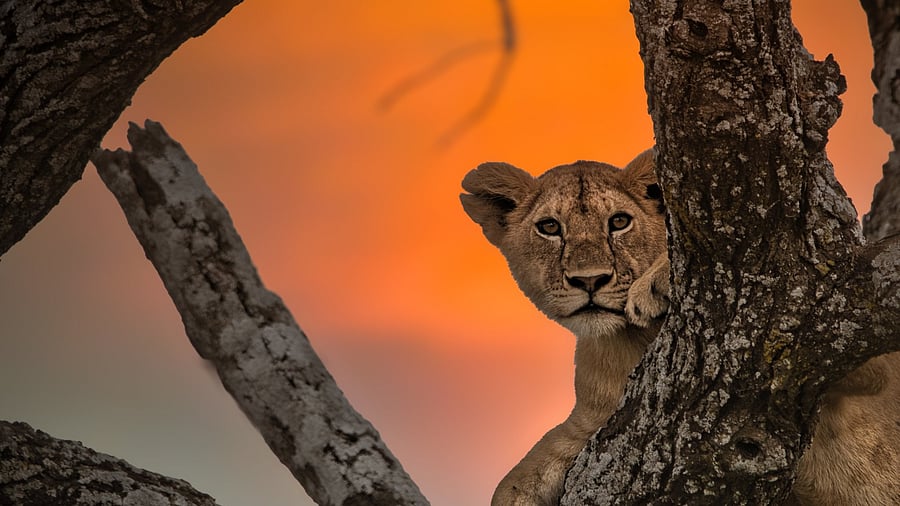
A lion cub perched on a tree.
Credit: PHOTO BY AUTHOR
You see as far as your eye can see.
That’s what you’ve always heard, and it’s easy enough to understand. What’s a little less intuitive is how far that ‘far’ really is. Five kilometres is usually where the Earth begins to curve away from you at the horizon, but in the constricted cities we live in, that distance doesn’t quite sink in. It’s only in places like Serengeti National Park in Tanzania that this distance truly hits home. The word “Serengeti” — derived from the Masai word “Siringet” — literally means “the endless plains,” but it’s only when you visit that you realise how truly endless it is.
So much so that I turn to our naturalist, Grace, who is driving our safari vehicle, and pointing to a tiny, almost invisible speck in the distance, which I assume to be rocks, I ask her, “Are we really headed there?”
My incredulity is not lost on her, but she smiles and says, “You bet we are!”
It looks so far to me that I’d think we’d never reach it, but in the 15,000 square kilometres over which Serengeti National Park stretches, chasing the horizon is a big part of what you do!
It’s the land of golden grass and endless sky, a place that has always enthralled wildlife enthusiasts. It was mostly unknown to the wider world until about 70 years ago when the work of Bernhard and Michael Grzimek, who produced a book and documentary titled Serengeti Shall Not Die, brought the region and its wildlife to a global audience. Very few can forget, growing up, watching endless films on the BBC, Discovery Channel, and Animal Planet, of lion prides ambushing and hunting the unending herds of antelope and zebra, of the cheetah’s blistering sprint through the grasslands after impala, and countless other tales that comprise the endless circle of life and struggle between the great cats and their prey.
From the light aircraft in which we fly into the Seronera Airstrip, the park below resembles a yellow-green carpet, interspersed with copses of acacia and stony outcrops called ‘kopjes.’ As soon as we head out of the small but bustling airstrip towards our camp, it’s almost as if one of those TV shows is unfolding live.
Magnificent, stately giraffes, hesitant yet elegant in their every step, line the road, inspecting with curiosity every safari vehicle that passes by. Majestic elephants, the true giants of the savannah, amble in herds across the grassland — huge beyond imagination, but still dwarfed by the immensity of grass and sky. In the distant stretches of yellow grassland, wildebeests dot the landscape: the classic herd of Africa that never stops and never rests, circumambulating this vast ecosystem in tune with the sun, the rain, and the insatiable urge for fresh grass. Zebras, one of the prettiest and starkest creatures of Africa, are not to be left behind. And, of course, we cannot forget the fiercest animal in Africa — the buffalo, which reminds you of the primordial forces of raw courage, strength, and doggedness.
The last unforgettable act we have on a safari one evening is a leopard in the distance, breathtaking in its silent beauty, giving us a casual look as we gaze at it, utterly spellbound. And then there are the lions. Perched atop the few sausage trees that dot the grasslands to have a bird’s-eye view of any action unfolding in the grass, the lion pride, including the younger ones, seems perfectly content to be lazy. Yet, predators they are, and it’s easy to sense they are just a heartbeat away from being alert in case an opportunity for a meal presents itself. We watch them for quite some time as the sun begins to set, and the sky is set alight by the brushwork of a master painter.
There are sunsets, and then there are sunsets in Africa. In shades of red and yellow, and later in pink and violet, the sky marks the passing of the day most dramatically and breathtakingly.
As the sun slips below that horizon we’ve been chasing all day, the firmament is set on fire, alight with endless colour, shades that change constantly, defying all manner of names and descriptions. It’s a tapestry that makes time slow down and takes you with it, drinking in these moments of sheer magic, as the dark takes over the last act with its calls of crickets, owls, and foxes. Then, the African night comes to life as hyenas begin to whoop and chuckle, and in the distance, a male lion roars its dominance.
Visit, if you will, but at your own risk, because chasing that horizon and the wildlife of the Serengeti that comes with it can be quite an addiction!
How to go?
Mt Kilimanjaro Airport is the usual international entry point, well-connected by airlines based in the Gulf. Arusha, a short ride away, is where air links to the safari parks begin, though long road transfers are always an option.
When to go?
Serengeti is an all-weather destination. The great herds and their ceaseless migration move in a circular pattern with the seasons, and it depends on where and when you want to track them. Typically, all months of the year are great for Serengeti, but the relatively low season is from mid-March to mid-May and November to December.
Where to stay?
There is a plethora of options, especially if you are driving from one park in Tanzania to another. Research well and choose the option that suits you, since the Serengeti is vast, and not all camps can do justice to every area of the massive park.